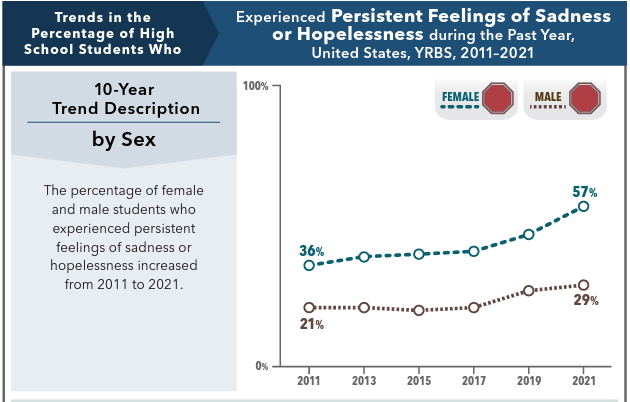Teen girls’ mental health didn’t fare well through COVID
The latest Centers for Disease Control and Prevention (CDC) Youth Risk Behavior Survey shows that the mental health of all youth, but particularly teenage girls, did not fare well through COVID-19.
The report includes data collected from more than 17,000 U.S. high school students in fall 2021 — the first survey data collected since the start of COVID — as well as 10-year trends (from 2011-2021) on health behaviors and experiences. The survey results add on to other research and surveys that have found severe impacts of the pandemic on adolescent health and well-being.
Mental health challenges among adolescents in general were exacerbated during COVID, with school closures and other disruptions in daily life likely contributing to the impact.
Female students compared to male students have fared more poorly “across almost all measures of substance use, experiences of violence, mental health, and suicidal thoughts and behaviors,” according to the survey. “These differences, and the rates at which female students are reporting such negative experiences, are stark.”
Below are charts showing the most striking statistics.
Persistent feelings of sadness or hopelessness
Almost 60 percent of high school girls reported experiencing persistent feelings of sadness or hopelessness in 2021. This is a dramatic increase from 2019 to 2021, and a significantly higher percentage than male students reporting the same feelings. Trends for both sexes are moving in the wrong direction (noted below by the red stop sign).
Made a suicide plan during the past year
The percentage of female students who had made a suicide plan increased from 2019 to 2021, adding on to another uptick seen from 2017 to 2019. The percentage of male students who made a suicide plan did not change and has remained relatively the same over the past 10 years.
Attempted suicide during the past year
The percentage of female students who attempted suicide increased from 2019 to 2021, as it had from 2017 to 2019. After increasing from 2017 to 2019, the percentage of male students who attempted suicide did not change from 2019 to 2021, and is largely unchanged from 2011.


